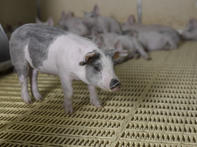
Broken Bones
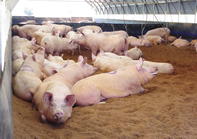
Broken bones and injuries may be avoided through good handling, having non-slippery, even, dry, floors and by not overcrowding animals. SAPPO suggests that pigs with broken bones be slaughtered as soon as possible to prevent a further deterioration in the health of the animal and to reduce the animal’s suffering.
Spinal Injuries and Abscesses
Spinal injuries or abscesses may be due to injuries caused by a hard blow across the back of the spine, the animal slipping and twisting or a boar being too heavy for a sow. Infections, due to tail biting for example, may result in abscesses in the spine. These conditions will result in the pig either remaining in a dog-sitting position and dragging its hindquarters to move or remain in a lying position.As with broken bones, it can be prevented through good handling, having non-slippery, even, dry floors and not overcrowding animals. Care should also be taken not to use much larger boars on sows and to prevent tail-biting, which is usually attributed to overcrowding, not enough feeding space and high disease levels. Sows that have been injured, may recover with rest, but serious spinal injuries and abscesses may not respond to treatment.
Bone Problems
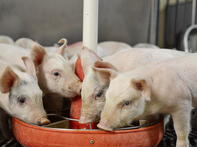
To avoid this problem, farmers should give their pigs a balanced diet throughout the production cycle. Farmers should also be aware of the impact of excessive water hardness or high concentrations of iron or heavy metals in water as these can antagonize trace mineral absorption, which can lead to the development of foot lesions. An added source of calcium or phosphorous may be given to pigs that suffer from a nutritional deficit, but pigs that cannot walk or are in obvious pain should be slaughtered.
Arthritis
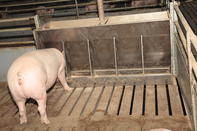
Tips to prevent arthritis, includes practicing good hygiene, disinfecting the navel of young piglets after birth and controlling feed intake and breeding sturdy animals. Pigs for Profit advises farmers to talk to their veterinarians about treatment, since arthritis may respond well to antibiotics. Damage to the joints, however, may become so severe that the best way to deal with the problem would be to slaughter the pig.
Poisoning
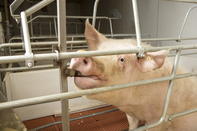
Flooring
The MSD Veterinary Manual in its Overview of lameness identifies flooring type as a major determinant of lameness, with all types of floors having “lameness associated with them.” Dirt and pasture, for example, can be too dry or too wet, leading to foot problems and infections, whereas bedding could be a source of bacteria that causes infectious arthritis, such as Erysipelothrix rhusiopathia.The state of the floor may also affect lameness if it is too slippery, wet or there are holes, gaps and sharp edges that may cause injuries.By Glenneis Kriel